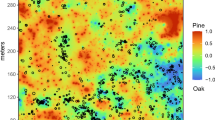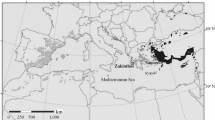Abstract
Cottonwoods are poplars (Populus sp.) adapted to riparian (streamside) zones and an understanding of their growth within these zones will assist with river management for cottonwood conservation and in the recognition of superior parental genotypes for hybrid poplar breeding programs. In this study we analyzed cottonwood growth in native riparian zones and compared growth along three study reaches of the Oldman River in Alberta, Canada that differed in geomorphic context, particularly the extent that the river channel was constrained by steep banks and bedrock. We used dendrochronology to analyze trunk growth patterns, and measured annual radial increments (RI) and basal area increments (BAI) of 278 narrowleaf cottonwoods (P. angustifolia), black cottonwoods (P. trichocarpa), their intrasectional hybrids, and natural intersectional hybrids with prairie cottonwoods (P. deltoides). The trees displayed common growth patterns with four phases: (I) a 3–7-year establishment phase with RI of about 1–2 mm/year, (II) a growth acceleration phase of about 15 years with RI increasing to the (III) RI growth peak of about 3 mm/year, and then (IV) the mature growth phase with relatively constant BAI and progressively declining RI. This general pattern was consistent across study reaches but the durations and growth rates of the phases differed along with forest stand structure. Along the unconstrained alluvial reach with a broad floodplain and dynamic channel, extensive and dense forest groves occurred. This increased tree competition, as evidenced by reduced RI and BAI in the mature phase. In contrast, along a constrained reach trees were restricted to sparse, narrow bands and their increased growth rates in the mature phase probably reflected reduced competition. Cottonwoods along the intermediate reach demonstrated an intermediate combination of forest and growth characteristics. Genotypic effects were slight although P. angustifolia had reduced RI during the establishment phase. These results demonstrate that within native riparian zones cottonwoods display an inherent growth pattern that reflects the trees' life history, and that growth rates and transitions are influenced by the geomorphic context that influences forest structure.








Similar content being viewed by others
References
Amlin NM, Rood SB (2003) Drought stress and recovery of riparian cottonwoods due to water table alteration along Willow Creek, Alberta. Trees 17:351–358
Campbell JS, Mahoney JM, Rood SB (1993) A lack of heterosis in natural poplar hybrids from southern Alberta. Can J Bot 71:37–42
Canham CD, LePage PT, Coates KD (2004) A neighborhood analysis of canopy tree competition: effects of shading versus crowding. Can J For Res 34:778–787
Ceulemans R, Scarasciamugnozza G, Wiard BM, Braatne JH, Hinckley TM, Stettler RF, Isebrands JG, Heilman PE (1992) Production physiology and morphology of Populus species and their hybrids grown under short rotation. 1. Clonal comparisons of 4-year growth and phenology. Can J For Res 22:1937–1948
Cooper DJ, Merritt DM, Andersen DC, Chimner RA (1999) Factors controlling the establishment of Fremont cottonwood seedlings on the upper Green River, USA. Reg Rivers Res Manage 15:419–440
Disalvo AC, Hart SC (2002) Climatic and stream-flow controls on tree growth in a western montane riparian forest. Environ Manage 30:678–691
Dudek DM, McClenahen JR, Mitsch WJ (1998) Tree growth responses of Populus deltoides and Juglans nigra to streamflow and climate in a bottomland hardwood forest in central Ohio. Am Midl Nat 140:233–244
Eckenwalder JE (1996) Systematics and evolution of Populus. In: Stettler RF, Bradshaw JHD, Heilman PE, Hinckley TM (eds) Biology of Populus and its implications for management and conservation. NRC Research, Ottawa, Ontario, Canada, pp 7–32
Farrar JL (1995) Trees in Canada. Fitzhenry and Whiteside, Markham, Ontario, Canada
Floate KD (2004) Extent and patterns of hybridization among the three species of Populus that constitute the riparian forest of southern Alberta, Canada. Can J Bot 82:253–264
Fritts HC (1976) Tree rings and climate. Academic, London
Harner MJ, Stanford JA (2003) Differences in cottonwood growth between a losing and a gaining reach of an alluvial floodplain. Ecology 84:1453–1458
Heilman PE, Stettler RF (1985) Genetic-variation and productivity of Populus trichocarpa and its hybrids. 2. Biomass production in a 4-year plantation. Can J For Res 15:384–388
Hinckley TM, Braatne JH, Cleulemans R, Clum P, Dunlap J, Newman D, Smit B, Scarascia-Mugnozza G, van Volkenburgh E (1992) Growth dynamics and canopy structure. In: Mitchell CP, Ford-Robertson JB, Hinckley T, Sennerby-Forsse L (eds) Ecophysiology of short-rotation forest crops. Elsevier Science, London and New York, pp 1–34
Hökkä H, Groot A (1999) An individual-tree basal area growth model for black spruce in second-growth peatland stands. Can J For Res 29:621–629
Hughes FMR (1997) Floodplain biogeomorphology. Prog Phys Geogr 21:501–529
Johnson WC (1994) Woodland expansion in the Platte River, Nebraska— Patterns and causes. Ecol Monogr 64:45–84
Kalischuk AR, Rood SB, Mahoney JM (2001) Environmental influences on seedling growth of cottonwood species following a major flood. For Ecol Manage 144:75–89
Kozlowski TT (1958) Water relations and growth of trees. J For 56:498–502
Kozlowski TT, Pallardy SG (1997) Physiology of woody plants. Academic, San Diego, CA
Kranjcec J, Mahoney JM, Rood SB (1998) The responses of three riparian cottonwood species to water table decline. For Ecol Manage 110:77–87
Krinard RM, Johnson RL (1980) Fifteen years of cottonwood plantation growth and yield. S J Appl For 4:180–185
Mahoney JM, Rood SB (1991) A device for studying the influence of declining water-table on poplar growth and survival. Tree Physiol 8:305–314
Mahoney JM, Rood SB (1998) Streamflow, requirements for cottonwood seedling recruitment—an integrative model. Wetlands 18:634–645
McKenzie D, Hessl AE, Peterson DL (2001) Recent growth of conifer species of western North America: assessing spatial patterns of radial growth trends. Can J For Res 31:526–538
Nadezhdina N, Cermak J, Ceulemans R (2002) Radial patterns of sap flow in woody stems of dominant and understory species: scaling errors associated with positioning of sensors. Tree Physiol 22:907–918
Pedersen BS, Howard JL (2004) The influence of canopy gaps on overstory tree and forest growth rates in a mature mixed-age, mixed-species forest. For Ecol Manage 196:351–366
Poage NJ, Tappeiner JC (2002) Long-term patterns of diameter and basal area growth of old-growth Douglas-fir trees in western Oregon. Can J For Res 32:1232–1243
Rood S, Campbell J, Despins T (1986) Natural poplar hybrids from southern Alberta: I. Continuous variation for foliar characteristics. Can J Bot 64:1382–1388
Rood SB, Mahoney JM, Reid DE, Zilm L (1995) Instream flows and the decline of riparian cottonwoods along the St. Mary River, Alberta. Can J Bot 73:1250–1260
Rood SB, Patino S, Coombs K, Tyree MT (2000) Branch sacrifice: cavitation-associated drought adaptation of riparian cottonwoods. Trees 14:248–257
Rood SB, Braatne JH, Hughes FMR (2003) Ecophysiology of riparian cottonwoods: stream flow dependency, water relations, and restoration. Tree Physiol 23:1113–1124
Samuelson GM, Rood SB (2004) Differing influences of natural and artificial disturbances on riparian cottonwoods from prairie to mountain ecoregions in Alberta, Canada. J Biogeogr 31:435–450
Schume H, Grabner M, Eckmullner O (2004) The influence of an altered groundwater regime on vessel properties of hybrid poplar. Trees 18:184–194
Scott ML, Auble GT, Friedman JM (1997) Flood dependency of cottonwood establishment along the Missouri River, Montana, USA. Ecol Appl 7:677–690
Sperry JS, Nichols KL, Sullivan JEM, Eastlack SE (1994) Xylem embolism in ring-porous, diffuse-porous, and coniferous trees of northern Utah and interior Alaska. Ecology 75:1736–1752
Stanturf JA, van Oosten V, Netzer DA, Coleman MD, Portwood CJ (2001) Ecology and silviculture of poplar plantations. In: Dickmann DI, Isebrands JG, Eckenwalder JE, Richardson J (eds) Poplar culture in North America. NRC Research, Ottawa, Ontario, Canada, pp 153–206
Stettler RF, Zsuffa L, Wu R (1996) The role of hybridization in the genetic manipulation of Populus. In: Stettler RF, Bradshaw HD, Heilman PE, Hinckley TM (eds) Biology of Populus and its implications for management and conservation. NRC Research, Ottawa, Ontario, Canada, pp 87–112
Stokes MA, Smiley TL (1968) An introduction to tree-ring dating. The University of Chicago Press, Chicago
Stromberg JC, Patten DT (1996) Instream flow and cottonwood growth in the eastern Sierra Nevada of California, USA. Reg Rivers Res Manage 12:1–12
Stromberg JC, Patten DT, Richter BD (1991) Flood flows and dynamics of Sonoran riparian forests. Rivers 2:221–235
Tyree MT, Kolb KJ, Rood SB, Patino S (1994) Vulnerability to drought-induced cavitation of riparian cottonwoods in Alberta—a possible factor in the decline of the ecosystem. Tree Physiol 14:455–466
Willms CR (2005) The influence of geomorphology and flow regulation on riparian cottonwoods. M.Sc. thesis, University of Lethbridge, Alberta, Canada
Willms J, Rood SB, Willms W, Tyree M (1998) Branch growth of riparian cottonwoods: a hydrologically sensitive dendrochronological tool. Trees 12:215–223
Acknowledgements
This research comprised part of the M.Sc. thesis of the senior author. The inputs of John Mahoney of Alberta Environment, Jim Byrne of the University of Lethbridge, and Derald Smith of the University of Calgary are gratefully acknowledged. We thank Kevan Berg, Sarah Bigelow, and Bobbi George for field assistance and acknowledge the funding provided by the Alberta Ingenuity Centre for Water Research, Alberta Environment, and a Natural Sciences and Engineering Research Council of Canada grant to S. Rood.
Author information
Authors and Affiliations
Corresponding author
Rights and permissions
About this article
Cite this article
R. Willms, C., W. Pearce, D. & B. Rood, S. Growth of riparian cottonwoods: a developmental pattern and the influence of geomorphic context. Trees 20, 210–218 (2006). https://doi.org/10.1007/s00468-005-0027-1
Received:
Accepted:
Published:
Issue Date:
DOI: https://doi.org/10.1007/s00468-005-0027-1




